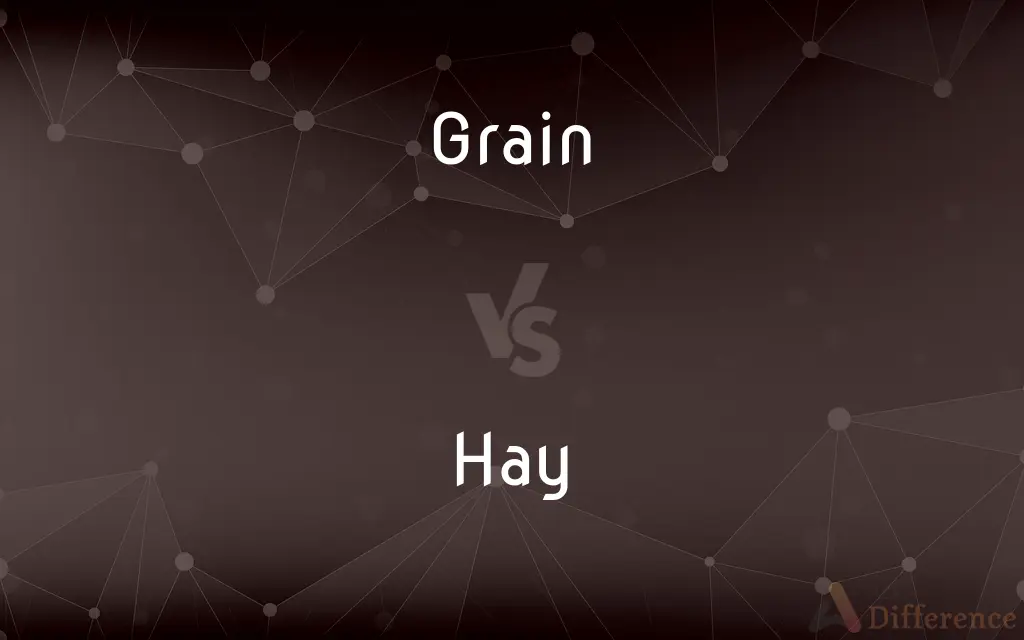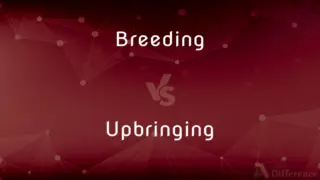Grain vs. Hay — What's the Difference?
By Tayyaba Rehman & Maham Liaqat — Updated on May 1, 2024
Grain is a hard seed harvested from cereal plants and used primarily as food, while hay is dried grass or legumes used mainly as animal fodder.

Difference Between Grain and Hay
Table of Contents
ADVERTISEMENT
Key Differences
Grain refers to the small, hard seeds from cereal plants like wheat, corn, and rice, primarily cultivated for human and livestock consumption. On the other hand, hay consists of grass, legumes, or other herbaceous plants that have been cut, dried, and stored for use as animal fodder.
Grains are high in carbohydrates and are a staple food source for both people and animals, providing essential nutrients like proteins and vitamins. Whereas hay is primarily used to feed livestock such as cattle, horses, and sheep, providing fiber and lesser amounts of protein.
The cultivation of grain involves planting seeds and harvesting the mature seeds, which are then processed for various uses including food production. In contrast, hay production involves cutting plants, allowing them to dry, and then baling them for storage and transport.
Grains can be stored for long periods due to their low moisture content, making them a crucial resource for food security. Hay, while also storable, tends to have a shorter shelf life and can be susceptible to mold if not properly dried and stored.
Grains play a vital role in human diets across the world and are processed into various forms such as flours, oils, and cereals. Hay is less versatile, predominantly serving as roughage to maintain the digestive health of ruminant animals.
ADVERTISEMENT
Comparison Chart
Primary Use
Human and animal food
Animal fodder
Composition
Hard seeds of cereal plants
Dried grasses, legumes, or other herbaceous plants
Nutritional Content
High in carbohydrates, proteins, vitamins
High in fiber, lower in protein
Production Process
Cultivated, harvested, processed
Cut, dried, baled
Storage
Long shelf life, low moisture content
Shorter shelf life, risk of mold if damp
Compare with Definitions
Grain
Hard seeds from cereal plants used as a staple food.
Rice, a type of grain, is a primary food source in Asia.
Hay
Grass cut and cured for fodder.
Make hay while the sun shines.
Grain
Stored in silos due to its dry, preservable nature.
Wheat grain is kept in silos until it's milled into flour.
Hay
Often used to provide roughage to ruminants like cows and horses.
Horses at the stable eat hay daily to aid digestion.
Grain
Basic temperament or nature; disposition.
It goes against my grain to ask for help.
Hay
Dried grass or legumes used for feeding livestock.
The farmer stores hay to feed his cattle during the winter.
Grain
Essential for producing flour, oils, and other food products.
Corn grain is processed into cornmeal and syrup.
Hay
Grass mowed and cured for use as fodder.
Grass or other plants, such as clover or alfalfa, cut and dried for fodder.
Grain
A grain is a small, hard, dry seed - with or without an attached hull or fruit layer - harvested for human or animal consumption. A grain crop is a grain-producing plant.
Hay
Hay is grass, legumes, or other herbaceous plants that have been cut and dried to be stored for use as animal fodder, particularly for large grazing animals raised as livestock, such as cattle, horses, goats, and sheep. However, it is also fed to smaller domesticated animals such as rabbits and guinea pigs.
Grain
Wheat or any other cultivated cereal used as food.
Hay
(Slang) A trifling amount of money
Gets $100 an hour, which isn't hay.
Grain
A single fruit or seed of a cereal
A few grains of corn
Hay
To mow and cure grass and herbage for hay.
Grain
The smallest unit of weight in the troy and avoirdupois systems, equal to 1/5760 of a pound troy and 1/7000 of a pound avoirdupois (approximately 0.0648 gram).
Hay
To make hay on (a patch of land).
Grain
The longitudinal arrangement or pattern of fibres in wood, paper, etc.
He scored along the grain of the table with the knife
Hay
To make (grass or other plants) into hay.
Grain
A person's character or natural tendency.
Hay
To feed with hay.
Grain
Kermes or cochineal, or dye made from either of these.
Hay
(uncountable) Grass cut and dried for use as animal fodder.
Grain
Give a rough surface or texture to
Her fingers were grained with chalk dust
Hay
(countable) Any mix of green leafy plants used for fodder.
Grain
Paint (especially furniture or interior surfaces) in imitation of the grain of wood or marble.
Hay
(slang) Cannabis; marijuana.
Grain
Remove hair from (a hide).
Hay
A net set around the haunt of an animal, especially a rabbit.
Grain
Feed (a horse) on grain.
Hay
(obsolete) A hedge.
Grain
A small, dry, one-seeded fruit of a cereal grass, having the fruit and the seed walls united
A single grain of wheat.
Gleaned the grains from the ground one at a time. Also called caryopsis.
Hay
(obsolete) A net placed around the lair or burrow of an animal.
Grain
The fruits of cereal grasses especially after having been harvested, considered as a group
The grain was stored in a silo.
Hay
(obsolete) An enclosure, haw.
Grain
A cereal grass
Wheat is a grain grown in Kansas.
Hay
(obsolete) A circular country dance.
Grain
Cereal grasses considered as a group
Grain is grown along the river.
Hay
The letter for the h sound in Pitman shorthand.
Grain
A relatively small discrete particulate or crystalline mass
A grain of sand.
Hay
To cut grasses or herb plants for use as animal fodder.
Grain
A small amount or the smallest amount possible
Hasn't a grain of sense.
Hay
To lay snares for rabbits.
Grain
(Aerospace) A mass of solid propellant.
Hay
A hedge.
Grain
Abbr. gr. A unit of weight in the US Customary System, an avoirdupois unit equal to 0.002285 ounce (0.065 gram).
Hay
A net set around the haunt of an animal, especially of a rabbit.
Grain
The markings, pattern, or texture of the fibrous tissue in wood
Cherry wood has a fine grain.
Hay
To lay snares for rabbits.
Grain
The direction of such markings
Cut a board with the grain.
Hay
To cut and cure grass for hay.
Grain
The side of a hide or piece of leather from which the hair or fur has been removed.
Grain
The pattern or markings on this side of leather.
Grain
The pattern produced, as in stone, by the arrangement of particulate constituents.
Grain
The relative size of the particles composing a substance or pattern
A coarse grain.
Grain
A painted, stamped, or printed design that imitates the pattern found in wood, leather, or stone.
Grain
The direction or texture of fibers in a woven fabric.
Grain
A state of fine crystallization.
Grain
An essential quality or characteristic
"Toughness as a virtue ... is, needless to say, fully embedded in the American grain" (Benjamin DeMott).
Grain
(Archaic) Color; tint.
Grain
To cause to form into grains; granulate.
Grain
To paint, stamp, or print with a design imitating the grain of wood, leather, or stone.
Grain
To give a granular or rough texture to.
Grain
To remove the hair or fur from (hides) in preparation for tanning.
Grain
To form grains
The corn began to grain.
Grain
(uncountable) The harvested seeds of various grass food crops eg: wheat, corn, barley.
We stored a thousand tons of grain for the winter.
Grain
(uncountable) Similar seeds from any food crop, e.g., buckwheat, amaranth, quinoa.
Grain
(countable) A single seed of grass food crops.
A grain of wheat
Grains of oat
Grain
The crops from which grain is harvested.
The fields were planted with grain.
Grain
(uncountable) A linear texture of a material or surface.
Cut along the grain of the wood.
He doesn't like to shave against the grain.
Grain
(countable) A single particle of a substance.
A grain of sand
A grain of salt
Grain
(countable) Any of various small units of mass originally notionally based on grain's weight, variously standardized at different places and times, including
Grain
The English grain of 5760 troy pound or 7000 pound avoirdupois, now exactly 64.79891 mg.
Grain
The metric, carat, or pearl grain of 4 carat used for measuring precious stones and pearls, now exactly 50 mg.
Grain
(historical) The French grain of 9216 livre, equivalent to 53.11 mg at metricization and equal to exactly 54.25 mg from 1812–1839 as part of the mesures usuelles.
Grain
Any of various small units of length originally notionally based on a grain's width, variously standardized at different places and times.
Grain
The carat grain of 4 carat as a measure of gold purity, creating a 96-point scale between 0% and 100% purity.
Grain
(materials) A region within a material having a single crystal structure or direction.
Grain
(rocketry) The solid piece of fuel in an individual solid-fuel rocket engine.
Grain
A reddish dye made from the coccus insect, or kermes; hence, a red color of any tint or hue, as crimson, scarlet, etc.; sometimes used by the poets as equivalent to Tyrian purple.
Grain
The hair side of a piece of leather, or the marking on that side.
Grain
(in the plural) The remains of grain, etc., after brewing or distillation; hence, any residuum. Also called draff.
Grain
(botany) A rounded prominence on the back of a sepal, as in the common dock.
Grain
Temper; natural disposition; inclination.
Grain
Visual texture in processed photographic film due to the presence of small particles of a metallic silver, or dye clouds, developed from silver halide that have received enough photons.
Grain
A branch of a tree; a stalk or stem of a plant.
Grain
A tine, prong, or fork.
Grain
One of the branches of a valley or river.
Grain
An iron fish spear or harpoon, with a number of points half-barbed inwardly.
Grain
A blade of a sword, knife, etc.
Grain
(founding) A thin piece of metal, used in a mould to steady a core.
Grain
To feed grain to.
Grain
(transitive) To make granular; to form into grains.
Grain
(intransitive) To form grains, or to assume a granular form, as the result of crystallization; to granulate.
Grain
To texture a surface in imitation of the grain of a substance such as wood.
Grain
(tanning) To remove the hair or fat from a skin.
Grain
(tanning) To soften leather.
Grain
To yield fruit.
Grain
See Groan.
Grain
To paint in imitation of the grain of wood, marble, etc.
Grain
To form (powder, sugar, etc.) into grains.
Grain
To take the hair off (skins); to soften and raise the grain of (leather, etc.).
Grain
To yield fruit.
Grain
To form grains, or to assume a granular form, as the result of crystallization; to granulate.
Grain
A single small hard seed; a kernel, especially of those plants, like wheat, whose seeds are used for food.
Grain
The fruit of certain grasses which furnish the chief food of man, as corn, wheat, rye, oats, etc., or the plants themselves; - used collectively.
Storehouses crammed with grain.
Grain
Any small, hard particle, as of sand, sugar, salt, etc.; hence, any minute portion or particle; as, a grain of gunpowder, of pollen, of starch, of sense, of wit, etc.
I . . . with a grain of manhood well resolved.
Grain
The unit of the English system of weights; - so called because considered equal to the average of grains taken from the middle of the ears of wheat. 7,000 grains constitute the pound avoirdupois, and 5,760 grains the pound troy. A grain is equal to .0648 gram. See Gram.
Grain
A reddish dye made from the coccus insect, or kermes; hence, a red color of any tint or hue, as crimson, scarlet, etc.; sometimes used by the poets as equivalent to Tyrian purple.
All in a robe of darkest grain.
Doing as the dyers do, who, having first dipped their silks in colors of less value, then give' them the last tincture of crimson in grain.
Grain
The composite particles of any substance; that arrangement of the particles of any body which determines its comparative roughness or hardness; texture; as, marble, sugar, sandstone, etc., of fine grain.
Hard box, and linden of a softer grain.
Grain
The direction, arrangement, or appearance of the fibers in wood, or of the strata in stone, slate, etc.
Knots, by the conflux of meeting sap,Infect the sound pine and divert his grainTortive and errant from his course of growth.
Grain
The fiber which forms the substance of wood or of any fibrous material.
Grain
The hair side of a piece of leather, or the marking on that side.
Grain
The remains of grain, etc., after brewing or distillation; hence, any residuum. Also called draff.
Grain
Temper; natural disposition; inclination.
Brothers . . . not united in grain.
Grain
A sort of spice, the grain of paradise.
He cheweth grain and licorice,To smellen sweet.
The red roses flush up in her cheeks . . . Likce crimson dyed in grain.
Grain
A branch of a tree; a stalk or stem of a plant.
Grain
A tine, prong, or fork.
Grain
A blade of a sword, knife, etc.
Grain
A thin piece of metal, used in a mold to steady a core.
Grain
A small hard particle;
A grain of sand
Grain
Foodstuff prepared from the starchy grains of cereal grasses
Grain
Used for pearls or diamonds: 50 mg or 1/4 carat
Grain
1/60 dram; equals an avoirdupois grain or 64.799 milligrams
Grain
1/7000 pound; equals a troy grain or 64.799 milligrams
Grain
Dry seedlike fruit produced by the cereal grasses: e.g. wheat, barley, Indian corn
Grain
The direction or texture of fibers found in wood or leather or stone or in a woven fabric;
Saw the board across the grain
Grain
Thoroughly work in;
His hands were grained with dirt
Grain
Paint (a surface) to make it look like stone or wood
Grain
Form into grains
Grain
Become granular
Common Curiosities
What is grain used for?
Grain is used primarily as food for humans and animals, and also for producing various food products.
How are grain and hay stored?
Grain is stored in dry, sealed environments like silos, while hay is baled and stored in dry areas to prevent mold.
How does the nutritional content of grain and hay differ?
Grain is rich in carbohydrates and protein, while hay is high in fiber but lower in protein.
Can humans consume hay?
No, hay is not suitable for human consumption; it is used for animal feed.
How does the production of grain and hay differ?
Grain production involves planting, growing, and processing seeds, whereas hay involves cutting, drying, and baling plants.
What is the main use of hay?
Hay is primarily used as fodder for feeding livestock, particularly ruminants.
Is grain more valuable than hay?
Grain generally holds more economic value due to its versatility and role in human diets.
What are the risks associated with storing hay?
Improperly dried or stored hay can develop mold, which is harmful to animals.
What types of plants are used to make hay?
Common plants used for hay include grasses, alfalfa, and clover.
What role does grain play in global agriculture?
Grain is a cornerstone of global agriculture, crucial for food security and a staple in diets worldwide.
Share Your Discovery

Previous Comparison
Breeding vs. Upbringing
Next Comparison
Frugality vs. PrudenceAuthor Spotlight
Written by
Tayyaba RehmanTayyaba Rehman is a distinguished writer, currently serving as a primary contributor to askdifference.com. As a researcher in semantics and etymology, Tayyaba's passion for the complexity of languages and their distinctions has found a perfect home on the platform. Tayyaba delves into the intricacies of language, distinguishing between commonly confused words and phrases, thereby providing clarity for readers worldwide.
Co-written by
Maham Liaqat















































